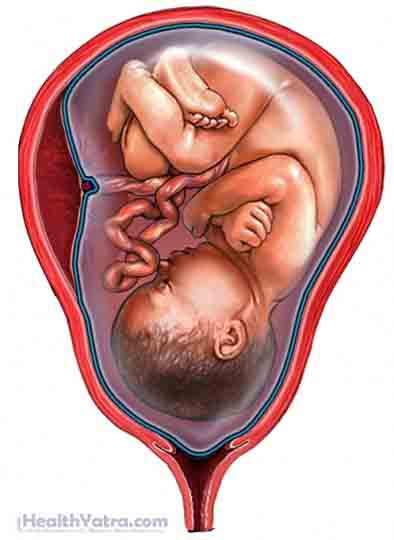تعريف
Oligohydramnios is too little fluid in the amniotic sac. The amniotic sac is the “water bag†inside the womb that cushions and protects your baby and allows normal growth and development. Normal amniotic fluid levels vary and the average volume during the pregnancy is almost one liter at 36-37 weeks. Less than 10% of pregnant women develop oligohydramnios.
Low amniotic fluid can indicate a problem in the mother or the baby. It can also cause problems that vary depending on when oligohydramnios occurs.
Problems in the first half of pregnancy:
- Higher risk of miscarriage
- Compression of the baby, leading to birth defects
- Lack of lung development
- Increased risk of infection
Problems in the second half of pregnancy:
- Reduced growth in baby
- Delivery before the baby is ready (called preterm birth)
- Problems during labor, possibly leading to cesarean delivery (“C-sectionâ€)
- Increased risk of infection
- Fetal distress in labor

أسباب
There are many known causes of oligohydramnios. However, sometimes a specific cause cannot be found. Conditions that can cause oligohydramnios:
- Birth defects (eg, neural tube defect)
- A problem with the placenta (the tissue that supplies the baby with nutrients through the umbilical cord)
- Tear in the amniotic sac (also called rupture of membranes)
- Pregnancy continuing past the due date
- Problems in the mother, such as dehydration, diabetes, or high blood pressure
- Complication of medicine
- ACE inhibitor (blood pressure medicine)
- Tocolytic medicine (to reduce uterine contractions)
عوامل الخطر
عامل الخطر هو شيء يزيد من فرص إصابتك بمرض أو حالة صحية معينة. وتشمل عوامل الخطر ما يلي:
- Advanced maternal age
- التدخين
الأعراض
If the amniotic sac has a tear, you may notice a gush of fluid from the vagina or that your underwear is wet all the time. Your doctor may notice that your abdomen is smaller than expected for your gestational age. However, oligohydramnios usually does not cause women to have any symptoms.
التشخيص
Your doctor will ask about your symptoms and medical history, and perform a physical exam. If you are not seeing a specialist in obstetrics already, you may be referred to one.
Tests:
- Ultrasound —a test that uses sound waves to examine your uterus (womb) and baby
- Amniotic fluid index—shows the amount of amniotic fluid based on the ultrasound picture; less than 5 cm means you have oligohydramnios
- Blood glucose—a blood test to check for diabetes
- Amniocentesis —removal of some amniotic fluid to check for birth defects or infection
العلاج
Your doctor will monitor you and your baby closely to make sure the condition does not get worse and that the fetus remains healthy. You will probably have more frequent prenatal visits and regular ultrasound tests. It is very important to keep these appointments.
تشمل خيارات العلاج ما يلي:
- More fluid intake. Some studies have found that having women drink two liters of water can increase the amount of amniotic fluid.
- Your doctor may add fluid to the amniotic sac once you are in labor to help cushion the umbilical cord during contractions.
- If you are diagnosed with oligohydramnios, it is important to take good care of yourself. Drink plenty of fluids, rest more often, stop smoking, and eat a healthful diet. If you see any signs of early labor (such as contractions or vaginal bleeding) contact your doctor right away.
الوقاية
The only way to prevent oligohydramnios is to treat its causes if possible. Getting regular check-ups while you’re pregnant can help find the problem early. If you are taking medications for blood pressure, see your doctor before getting pregnant.
